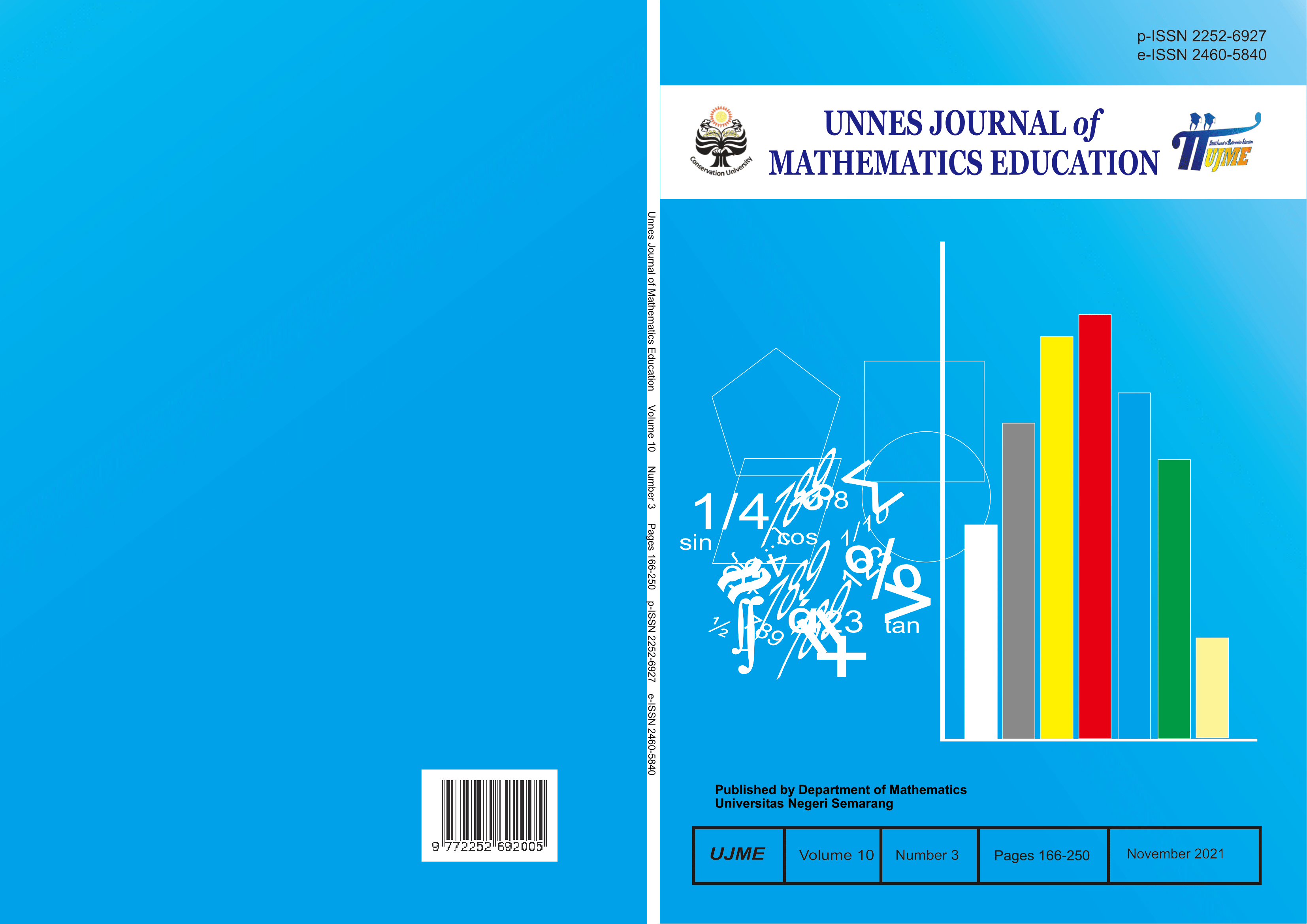Learning media development to improve students' spatial mathematical ability assisted by mobile phones using Augmented Reality
##plugins.themes.academic_pro.article.main##
Abstract
The purpose of this study was to describe the development of learning media to improve the Students' Spatial Mathematical Ability assist mobile phones using augmented reality and to determine the effectiveness of learning media assisted by mobile phones using augmented reality in team assisted individualization learning to improve students' mathematical spatial abilities. The development model used in this study is the ADDIE development model. ADDIE development stages are to Analyze, Design, Development, Implementation, and Evaluation. The population of this study was students of 8th grade at MTs Negeri 5 Magelang. The sample was taken from two classes with a random sampling technique from the population of 8th grade at MTs Negeri 5 Magelang. The results are: (1) a learning media has been developed in the form of an android application that uses augmented reality, which is named Bangun Ruang AR as a support for learning mathematics in build flat side space material. After going through the review and evaluation stage by media and material experts, the AR application is suitable to be used as a support for learning mathematics in build flat side space material with an eligibility percentage of 91.5% and included in the very good criteria and (2) The use of application learning media Bangun Ruang AR in Team Assisted Individualization learning effectively to improve students' mathematical spatial abilities, which is aimed at (a) Students' mathematical spatial abilities in team assisted individualization learning with learning media assisted by mobile phone using augmented reality achieve completeness; (b) There is an increase in students' mathematical spatial abilities in team assisted individualization learning with learning media assisted by mobile phone; (c) Students 'mathematical spatial abilities in team assisted individualization learning with learning media assisted by mobile phone are better than students' mathematical spatial abilities in conventional learning.
##plugins.themes.academic_pro.article.details##
References
Branch, Robert Maribe. (2009). Instructional Design: The ADDIE Approach. New York: Springer ScienceþBusiness Media
Fauzi, R. (2019). Increasing Student's Spatial Ability through the Use of the Team Assisted Individualization (TAI) Model at SMP Negeri 1 Pinangsori. MathEdu Journal (Mathematic Education Journal), 2 (02), 15-21. Available in https://journal.ipts.ac.id/index.php/MathEdu/article/download/1034/460
Huda, Miftahul. (2012). Cooperative Learning Methods, Techniques, Structures and Their Applications. Yogyakarta: Learning Library
Latifah, N., & Budiarto, MT (2019). Profile of Students' Spatial Reasoning in Solving Geometry Problems in terms of Mathematics Ability Level. Scientific Journal of Mathematics Education Volume, 8 (3).
Mullis IVS, et al. (2016). TIMSS 2015 International Result in Mathematics. Boston College: IEA
Nasution, EYP (2017). Improving Students' Spatial Ability Through 3D Cabri Assisted Geometry Learning. Mathline: Journal of Mathematics and Mathematics Education, 2 (2), 179-194.
National Council of Teachers of Mathematic (NCTM). (2000). Principle and Standards for School Mathematics. NCTM
Pavlovicova, G., & Svecoca, V. (2015). The Development of Spatial Skills through Discovering in the Geometrical Education at Primary School. Procedia Social and Behavioral Sciences, 186, 990-997. https://doi.org/10.1016/j.sbspro.2015.04.189.
Slavin. (2005). Cooperative Learning Theory, Research and Practice. Transleted by Yusron N. 2011. Bandung: Nusa Media.
Sugiyono. (2015). Educational Research Methods (Quantitative Approaches, Qualitative, and R & D). Bandung: Alfabeta.
Sumarni, Y. (2018). MATHEMATICS IN MANAGEMENT SCIENCE. Journal of Equation: Theory and Research of Mathematics Education, 1 (1), 11-24. Available in https://ejournal.iainbengkulu.ac.id/index.php/equation/article/download/1343/1133.
Syahputra, E. (2011). Increasing the Spatial Ability and Mathematical Disposition of Junior High School Students with the PMRI Approach to Computer Assisted Geometry Learning (Doctoral dissertation, Universitas Pendidikan Indonesia).
Syahputra, E. (2013). Increasing students' spatial abilities through the application of realistic mathematics learning. Cakrawala Pendidikan Journal, 3 (3). Available in https://journal.uny.ac.id/index.php/cp/article/viewFile/1624/1356.
Tambunan, SM (2006). The relationship between spatial ability and mathematics learning achievement. Hubs-Asia, 10 (1). Available in http://hubsasia.ui.ac.id/old/index.php/hubsasia/article/download/13/151
